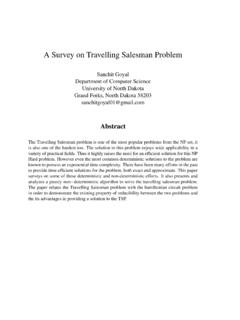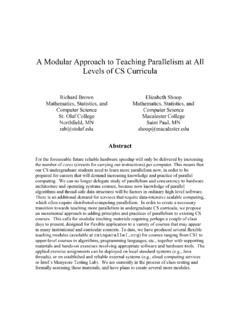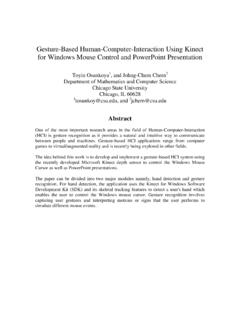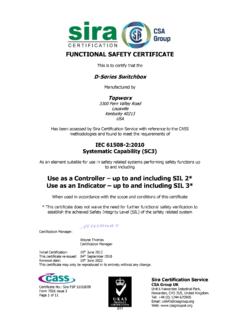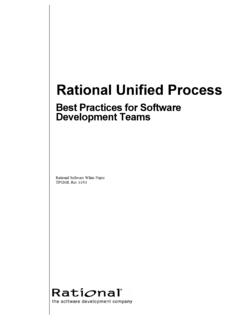Transcription of Verification & Validation of Object-Oriented …
1 Verification & Validation of Object-Oriented functional design using formal specification Techniques Vanessa Jackson & Emanuel Grant Department of Computer Science University of North Dakota Grand Forks, North Dakota 58202 Abstract UML is now an ISO standard used for graphically representing software systems. It possesses key advantages such as simplicity, intuitiveness and recently it has been considered as a semi- formal specification notation. However, UML falls short in the latter area because it utilizes loose semantics which leads to ambiguity among its models.
2 In some cases ambiguity can be negligible, however in safety critical systems this may lead to detrimental consequences. One technique to eliminate this ambiguity is to transform UML models into an analyzable representation with the use of formal specification techniques. Prior work has been conducted in formalizing UML class diagram attribute constraints and from that research, the work conducted here follows to demonstrate formalizing the operation signatures of the said classes within the UML class diagram.
3 This effort will look at how UML model Verification and Validation can be done by analyzing pre- and post-conditions of user-defined functions using Z notation a formal specification language. Keywords: Model transformation, formal specification technique , UML notation, safety critical system 1 1 Introduction Common to every scientific field are the many levels of technical understanding among different stakeholders of any development process. In order to sustain effective communication among distinct levels, information is typically represented through some type of model.
4 This model serves to abstract low-level or context-specific information in a manner that is comprehendible to most (if not all) stakeholders of the development undertaking. Likewise in software engineering, models are used to depict the key functional elements of a software system, and they are typically used to convey the essence of these functional elements to stakeholders of different technical backgrounds. The information they receive from models is used for many different purposes, all of which are important for successful integration of the efforts made by stakeholders in the software development process.
5 The elements that are within a model illustrate the individual system components and the communication which lies among them. In most instances, a model in itself can highlight how complex a software system is or will be based on the number of components displayed in the model and the coupling among them [1]. Models used in software engineering can be used in either a prescriptive manner where the model illustrates what the upcoming system ought to be, or descriptively where the model captures a system that has already been created.
6 Nevertheless, the primary purpose of modeling (to provide effective communication) can be accomplished when used in either approach. The model being analyzed in this paper was used in a descriptive manner. The most popular modeling language within software engineering used in both academia and industry is the Unified Modeling Language (UML). UML is a standard for system modeling and has been widely recognized and highly approved by industry professionals in most problem domains as a standard for modeling software systems.
7 Now certified as an ISO standard, UML is established in the field as the model for representing software systems due to its Object-Oriented design , general purpose (not domain specific) nature and most importantly its ease of use. UML contains a wide variety of models which captures both the static and dynamic aspects of software systems. It allows the designer of the model to stereotype standard UML notations into his/her own application-specific notations within a particular domain and therefore it provides room for customization [2].
8 While this may be an advantage to provide flexibility in using UML modeling, one weakness in doing so is that it introduces ambiguity among its models. Hence, the key issue which arises when software engineers consider using UML independently for formal specification is that due to the existence of fragile semantics, it can only be considered as a semi- formal specification language. To compensate for this shortcoming and to make it worthy of formal specification utilization, we demonstrate in this paper the transformation of UML models to an analyzable representation with the use of formal specification techniques.
9 The analyzable representation of the model is then explored and necessary corrections are carried out on the UML system models. In this research, we will formalize a UML class diagram which has been developed for a safety critical system. These are complex software systems where failure could lead to 2 loss of life, significant harm to property or to the environment in which it operates [3]. The safety critical system we explore is concerned with the successful implementation of an Unmanned Aerial Vehicles (UAV) monitoring system, which will operate in airspace.
10 Modeling in a problem domain of this nature and criticality is very significant for primarily communication among software developers and then secondarily, communication from the standpoint of developers to the many non-technical stakeholders involved in the project. As previously stated a UML class diagram has been developed of this system and the Z language will be used to formalize the model into an analyzable representation which will further be used for Verification and Validation (V&V) of the UAV monitoring system.



